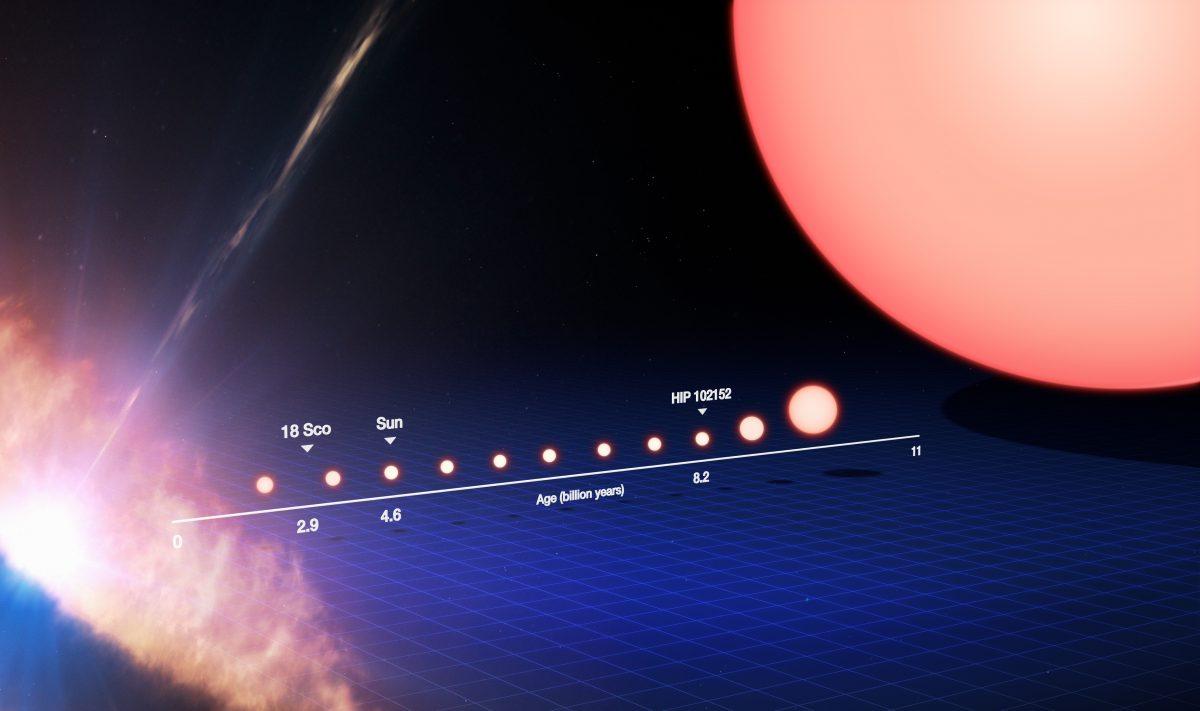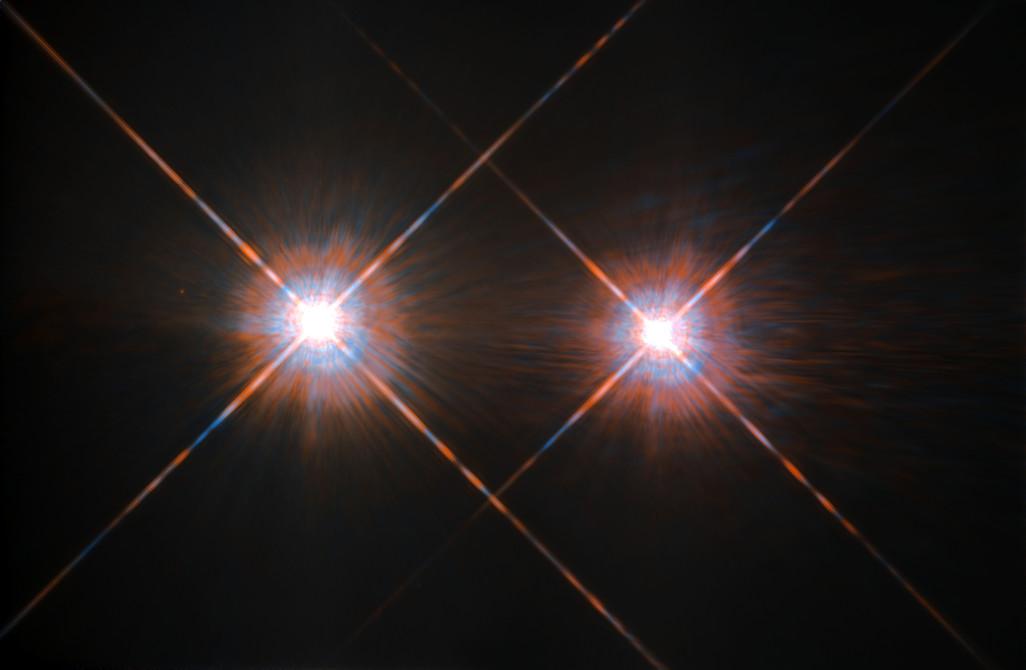Ask Ethan: Why do stars come in different sizes?

Even a single star, for example, our Sun, will greatly change its size during its life. How to explain the huge variety of stellar sizes that we observe today?
If we compare the planet Earth with the Sun, it turns out that it is necessary to put 109 lands one on another in order to fill the Sun from one side to the other. However, there are stars that are much smaller in size than the Earth - and much larger than even the Earth’s orbit around the Sun! How is this possible, and what exactly determines the size of the star? Our reader asks a question on this topic:
Why stars can grow to different sizes? From sizes slightly larger than Jupiter to sizes larger than Jupiter's orbit?
This question is more complicated than it seems, since, for the most part, the sizes of stars are not visible to us.

The image from the telescope, obtained as a result of deep scanning, in which stars are visible in the night sky, shows us stars of different colors and brightness, but all visible stars seem to be dots there. The difference in their sizes is only optical illusions that appear due to the nature of the cameras.
Even in a telescope, most of the stars seem to be points of light due to incredible distances from us to them. Their differences in color and brightness are easy to see, but size is a completely different matter. An object of a certain size at a certain distance will have what is called a certain angular diameter: the apparent size occupied by it in the sky. The closest sun-star, Alpha Centauri A , is located only 4.3 light years away, and is 22% larger than the Sun in radius.
')

Two Sun-like stars, Alpha Centauri A and B, are located 4.37 light-years from us and rotate around each other at a distance somewhere between the orbits of Saturn and Neptune. But even in the photo from Hubble, they look just like oversaturated light sources - the disk is not visible.
However, for us it has an angular diameter of 0.007 "(angular seconds), given that one angular minute holds 60 angular seconds, 1 angular degree — 60 angular minutes, and a full circle - 360 °. Even with a Hubble-type telescope the resolution is about 0.05 "; few stars in the universe can be considered in detail with this resolution. Usually these are closely spaced giants like Betelgeuse or R Golden Fish , some of the largest stars in angular diameter throughout the sky.

The radio image of a very large star, Betelgeuse, on which the size of the optical disk is imposed. This is one of the very few stars that from Earth can be seen not just as a point source of light.
Fortunately, there are indirect measurements that allow us to calculate the physical sizes of stars - and very reliable ones. If we take a spherical object, heated to such a state that it begins to emit radiation, then the total amount of radiation emitted by a star is determined only by two parameters: the temperature of the object and its physical size. The reason for this is that the only place the star radiates light into the Universe is its surface, and the surface of the sphere is always calculated using the formula 4 π r 2 , where r is the radius. If you can measure the distance to the star, its temperature and apparent brightness, you can find its radius (and, consequently, size) by simply applying the laws of physics.
 g
gA magnified image of the red giant UY Shield, in the telescope of the Rutherford Observatory. In most telescopes it can be seen only as a bright point, but this is the largest star known to mankind today.
By observing, we see that some stars are tens of kilometers in size, while others can be 1,500 times larger than the sun. Of the supergiant stars, the largest will be UY Shield , with a diameter of 2.4 billion km, which is larger than the orbit of Jupiter around the Sun. But such extreme examples of stars do not relate to stars resembling the sun. Of course, the most common type of star will be a star from the main sequence, such as our Sun: a star consisting mainly of hydrogen, which receives energy through the synthesis of helium from hydrogen in its core. And such stars also have a huge variety of sizes, determined by their mass.

The young region of star formation in our Milky Way. During the gravitational collapse of gas clouds, the protostars are heated and become denser, and as a result, the synthesis starts in their core
When a star is formed, gravitational contraction transforms the potential energy into the kinetic energy of the movement of particles in the core of a star. If there is enough mass, the temperature can rise to values that allow nuclear fusion to start in the inner parts of the star, and hydrogen will begin to turn into a helium by a chain reaction. In a star of small mass, only a small part in the very center will pass this milestone at 4,000,000 K and work on synthesis, and then at a very low speed. On the other hand, large stars can be hundreds of times as large as the Sun, and reach temperatures of tens of millions of degrees in the core, synthesizing helium from hydrogen at speeds that are millions of times higher than those of the Sun.

The modern spectral classification of Morgan-Kinan stars , with temperature regimes indicated above in kelvins. Most of the stars (75%) belong to class M, and only 1 out of 800 is heavy enough to become a supernova.
The smallest stars will have the lowest outgoing flows and radiation pressure, while the largest stars will have the largest. This outgoing radiation and energy holds the star against the gravitational collapse, but you may be surprised that the range of these values is rather narrow. In the lightest stars, for example, Proxima Centauri or Wolf 1055 V , the size does not exceed 10% of the sun - they are slightly larger than Jupiter. And the most massive of the famous stars, the blue giant R136a1 , is 250 times the Sun's mass - and only 30 times its diameter. If a star is engaged in the synthesis of helium from hydrogen, then its size will not vary greatly.

The cluster RMC 136 in the center of the Tarantula Nebula in the neighboring galaxy the Large Magellanic Cloud , contains the most massive of the known stars
But not every star produces helium synthesis from hydrogen! The smallest stars do not do synthesis at all, and the largest ones are in a much more energetic phase of their life. Types of stars can be broken down by size, and so we can get five general classes:
- Neutron stars: the mass of these supernova remnants will be from one to three solar, but in fact they are compressed into a giant atomic nucleus. They emit radiation, but in tiny quantities due to their small size. The size of a typical neutron star is 20-100 km.
- White dwarfs: are formed when the sun-like stars in the core ends up in helium fuel, and the outer layers scatter, and the inner layers shrink. Usually the mass of a white dwarf is from 0.5 to 1.4 times the mass of the Sun, but they are about the size of the Earth: about 10,000 km across, and consist of highly compressed atoms.
- Stars of the main sequence: this includes red dwarfs, stars of the solar type, blue giants, about which we have already spoken. Their size varies from 100,000 km to 30,000,000 km, they have a fairly large range of sizes, but even the largest of them in place of the Sun would not swallow Mercury.
- Red giants: what happens when hydrogen runs out in the core? If the star is not a red dwarf (and in this case it will simply turn into a white dwarf), the gravitational compression will warm the core so much that it will begin to produce carbon from helium. And this process releases much more energy than the synthesis with the participation of hydrogen, because of which the star is extremely swelling. Simple physics is that the force acting outward (radiation) at the edge of a star must balance the force acting inward (gravity) in order to maintain it in a stable state - so that with a much greater force acting outward, the size of the star will simply increase dramatically. In diameter, the red giants are usually from 100 to 150 million km: large enough to absorb Mercury, Venus, and possibly the Earth.
- Supergiants: the most massive stars pass farther, beyond the synthesis of helium, and begin to synthesize even heavier elements, such as carbon, oxygen and even silicon and sulfur. Fate is destined to become supernovae and / or black holes, but before that they swell to an enormous size, and can stretch a billion kilometers or more. These are the largest stars, such as Betelgeuse, and, replacing the Sun, they would swallow up all the rocky planets and the asteroid belt, and the largest would even swallow Jupiter.

Today, the Sun is very small compared with the giants, but will grow to the size of Arcturus in the red giant phase. But to the monstrous supergiant type Antares the Sun will never get
Such small remnants of large stars, like neutron stars and white dwarfs, shine so brightly and so long because the energy contained in them can escape only through their tiny surface. But the size of other stars is determined by a simple balance: the force from outgoing radiation on the surface should be equal to the gravitational pressure. The increase in radiation power inflates stars to a larger size, while the largest stars swell to billions of kilometers.

If the calculations are correct, the Sun, when it swells to a red giant, should not swallow the Earth. But it still gets very hot.
As the sun ages, its core warms up, and over time it expands and becomes hotter. After a couple of billions of years, it will become hot enough to boil the oceans of the Earth - if we don’t take anything to migrate our planet to a safe remote orbit. For a sufficiently long period of time, the Sun will swell to a red giant. For several hundred million years, it will become bigger and brighter than some of the most massive stars. But do not be deceived by this impressive fact: in astronomy, size matters, but it is not the only parameter. Both the smallest neutron stars and the largest supergiants, as well as many white dwarfs and main sequence stars will still be more massive than the Sun as a red giant!
Ethan Siegel - astrophysicist, popularizer of science, blog Starts With A Bang! He wrote the books Beyond The Galaxy , and Treknologiya: Star Trek Science [ Treknology ].
FAQ: if the universe is expanding, why aren't we expanding ; why the age of the universe does not coincide with the radius of the observed part of it .
Source: https://habr.com/ru/post/371167/
All Articles